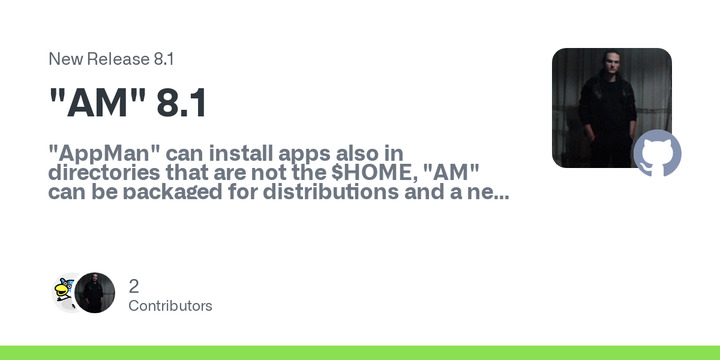"AM" 8.1
"AppMan" can install apps also in directories that are not the $HOME, "AM" can be packaged for distributions and a new option
-iafor AppImages is now available!As the title suggests, this release brings with it three very important new features, let's proceed in order.
1. "AppMan" can install apps also in directories that are not the $HOME
From now on you can choose a directory other than $HOME for the installation of your applications, even an external partition, as long as you have permissions to write to it.
This new feature makes "AppMan" already a step forward compared to "AM".
Thanks to @Samueru-sama for this improvement!
2. "AM" can be packaged for distributions
For those who decide to package "AM" for the repositories of some distribution, it is necessary to take into account this function inside the APP-MANAGER script, which is the heart of "AM"/"AppMan":
# DETERMINE WHEN TO USE "AM" OR "APPMAN" if [ "$(realpath "$0")" = "/opt/am/APP-MANAGER" ]; then _am mkdir -p "$MODULES_PATH" || exit 1 elif [ "$(realpath "$0")" = "/usr/bin/am" ]; then _am AMPATH="$AMCACHEDIR" MODULES_PATH="/usr/lib/am/modules" else _appman fithe above function specifies that if the "am" command is in /usr/bin, the "AMPATH" variable will be set to a writable directory (in our case we used "AMCACHEDIR", the $HOME/.cache/am directory) while the "MODULES_PATH" variable will be set to the system directory "/usr/lib/am/modules" you created, thus overriding the default values of "AM".
for this to work, you need to rename the "APP-MANAGER" script to "am" and place it in /usr/bin, while the "modules" directory must be placed in /usr/lib/am. Here is how a package structure should look like, according to the definitions currently in force:
/usr/bin/am /usr/lib/am/modules/database.am /usr/lib/am/modules/install.am /usr/lib/am/modules/management.am /usr/lib/am/modules/sandboxes.am /usr/lib/am/modules/template.amthe above scheme has already been tested on Debian Stable, a demo video is available here.
For this "special" redistribution, module updates and the CLI itself will be disabled, which will instead have to be managed by the package manager in use (APT, DNF, Emerge, YAY...).
NOTE, the above scheme may be changed, according to the distribution packagers' decisions. Suggestions for improving the implementation are welcome.
3. New option
-iafor AppImages is now availableLike the option
-i/install, but for AppImages only! Its now available the new option "-ia" or "install-appimage"!USAGE:
am -ia {PROGRAM} am -ia --debug {PROGRAM} am -ia --force-latest {PROGRAM}or
appman -ia {PROGRAM} appman -ia --debug {PROGRAM} appman -ia --force-latest {PROGRAM}In this example, I'll run the script
brave-appimagebut runningbrave, that instead is the original upstream package:install-appimage-2024-08-29_17.49.07.mkv.mp4
in the video above I first launch a "query" with the
-qoption to show you the difference betweenbraveandbrave-appimage, and then-q --appimagesto show you only the appimages from the list.All the new option "
-ia" does is to check on the AppImage's list if the "argument" exists, if not, another check will be done by adding "-appimage" at the end of the argument. If no argument is found, the command-iwill not not be launched, while if the argument exists, the option-iwill take care of the installation of the script and also of the flags --debug and --force-latest, if they exist.NOTE: by definition, the AppImages themselves "are not installed", but by installation we of the "AM" team mean adding the package, with its symbolic link, the version file, the icon directory and the script to update the application all, overall, in the dedicated paths. Generalizing, and above all for practical reasons, of language and syntax, we simplify the whole thing by calling this option "
install-appimage", or simply "-ia", in PacMan/YAY style.What's Changed
- allow appman to work outside
$HOMEtake 2 by @Samueru-sama in #889- improve detection of
$BINDIRAPP-MANAGER by @Samueru-sama in #890- fix conversion of old appman config APP-MANAGER by @Samueru-sama in #891
- Fix appman mode usage in AM for unprivileged users by @ivan-hc in #892
- Update CONTRIBUTING.md by @ivan-hc in #893
- "AM" 8.1 by @ivan-hc in #894
Full Changelog: 8...8.1
AM-Application-Manager 8.1 has been released.

